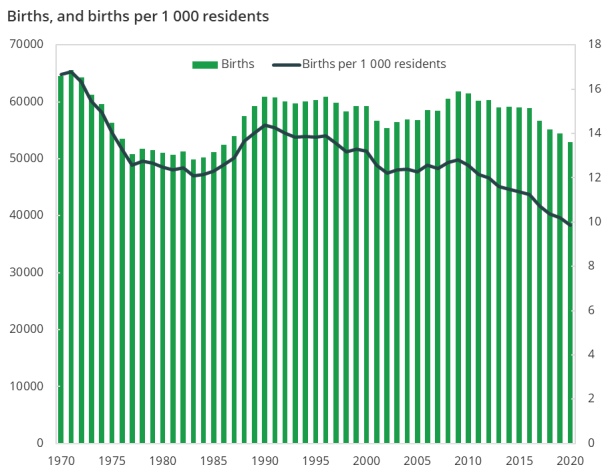Covid-induced immigration slump sees slowest population growth since 2001
Published:
By 1st January 2021, Norway’s population stood at 5 391 369. Population growth for 2020 came in at 23 800, making 2020 the year with the slowest population growth since 2001.
- Full set of figures
- Population
- Series archive
- Population (archive)
Relative to population size, Norway has not experienced such a low growth rate since 1990. These developments are related to the Covid-19 pandemic and the government’s responses to it, with immigration rates considerably reduced through much of the year, as revealed in the newly released yearly and quarterly population statistics.
Significantly fewer immigrations, especially during the spring
There were 38 100 immigrations in 2020, the lowest number since 2004. Each of the three years preceding 2020 saw between 14 100 and 20 100 more immigrations. The number of immigrations has been falling every year since 2012, but the 27 percent decline from 2019 to 2020 represents a slump of historical significance. Until 2020, the largest observed decline since 1950 occurred in 1958, reflecting a reduction of 17 percent.
Figure 1 presents the number of immigrations for each month of 2020 and compares this against the average monthly immigraitons observed for the years 2017-2019. The number of immigrations in January 2020 was slightly lower than the average immigrations in January for the three preceding years. This reflects the broader downward trend in immigration over recent years. However, as we move into the months of spring, we observe a considerable drop in immigrations in 2020. April stands out the most here, with 1 900 fewer immigrations than the average observed for 2017-2019.
Figure 1. Immigrations in 2020 and the average number of immigrations 2017-2019
| Month | 2020 | Average 2017-2019 |
| January | 4389 | 4582 |
| February | 3585 | 4080 |
| March | 1703 | 3268 |
| April | 599 | 2529 |
| May | 1594 | 2875 |
| June | 3186 | 3487 |
| July | 3349 | 3791 |
| August | 4466 | 5440 |
| September | 4936 | 5499 |
| October | 3240 | 4596 |
| November | 3190 | 4063 |
| December | 3834 | 3360 |
One of the consequences of the low number of immigrations was that the natural increase contributed more to population growth than net migration. This is the first time since 2004 that natural increase has contributed more than net migration to population growth in Norway. As a comparison, net migration in 2012 contributed 29 100 more individuals than the excess of births over deaths.
Figure 2. Natural increase and net migration 1970-2020
| Natural increase | Net migration | |
| 1970 | 25828 | -969 |
| 1971 | 26569 | 6615 |
| 1972 | 24885 | 4423 |
| 1973 | 21250 | 3444 |
| 1974 | 20139 | 4922 |
| 1975 | 16284 | 4769 |
| 1976 | 13258 | 4889 |
| 1977 | 11053 | 5034 |
| 1978 | 11067 | 3974 |
| 1979 | 9948 | 2746 |
| 1980 | 9699 | 4071 |
| 1981 | 8815 | 5176 |
| 1982 | 9791 | 5740 |
| 1983 | 7713 | 4285 |
| 1984 | 7693 | 3761 |
| 1985 | 6762 | 6228 |
| 1986 | 8954 | 7451 |
| 1987 | 9068 | 13769 |
| 1988 | 12172 | 10143 |
| 1989 | 14130 | -1453 |
| 1990 | 14918 | 1710 |
| 1991 | 15885 | 8045 |
| 1992 | 15378 | 9942 |
| 1993 | 13081 | 12808 |
| 1994 | 16021 | 7436 |
| 1995 | 15102 | 6366 |
| 1996 | 17067 | 5817 |
| 1997 | 15206 | 10700 |
| 1998 | 14240 | 13823 |
| 1999 | 14128 | 18999 |
| 2000 | 15232 | 9688 |
| 2001 | 12715 | 7955 |
| 2002 | 10969 | 17174 |
| 2003 | 13980 | 11285 |
| 2004 | 15751 | 13211 |
| 2005 | 15524 | 18439 |
| 2006 | 17292 | 23723 |
| 2007 | 16505 | 39652 |
| 2008 | 18785 | 43346 |
| 2009 | 20358 | 38637 |
| 2010 | 19943 | 42346 |
| 2011 | 18827 | 47032 |
| 2012 | 18263 | 47343 |
| 2013 | 17713 | 40073 |
| 2014 | 18690 | 38155 |
| 2015 | 18331 | 29802 |
| 2016 | 18164 | 26076 |
| 2017 | 15859 | 21349 |
| 2018 | 14280 | 18103 |
| 2019 | 13811 | 25327 |
| 2020 | 12368 | 11327 |
The effects of this change varies across municipalities. For example, in Oslo, net international migration is lower below 1 000 for the first year since 2000. When including internal migration (moves within Norway), the capital observed a negative net migration of 1 800. Net migration (including both international and internal migrations) and population growth have not been this low in Oslo since 2000, while the fourth quarter in 2020 revealed population decline for the first time since 2001. With that said, the capital did experience a total population growth of 3 500 in 2020 due to the natural increase.
Further population ageing in 2020
The Norwegian population aged further in 2020, something that is likely to continue for the years to come. By 1st January 2021, there were 11 000 fewer residents below the age of 20 than there had been just a year earlier. In the same period, the number of persons aged 67 years or more rose by 22 000. Thus, the increase for residents aged 67 years and older was almost the same as the total increase for the population (23 800).
Figure 3. Population 1st January by age group
| Category | 0-5 years | 6-12 years | 13-15 years | 16-19 years | 20-44 years | 45-66 years | 67-79 years | 80 years and over |
| 1971 | 394122.00 | 432162.00 | 185606.00 | 240759.00 | 1196452.00 | 1009136.00 | 343345.00 | 86723.00 |
| 1972 | 394417.00 | 435849.00 | 185454.00 | 244168.00 | 1208271.00 | 1011479.00 | 349085.00 | 89050.00 |
| 1973 | 392672.00 | 441020.00 | 184638.00 | 246327.00 | 1225820.00 | 1011385.00 | 355071.00 | 91301.00 |
| 1974 | 388026.00 | 446481.00 | 183844.00 | 246614.00 | 1243415.00 | 1009856.00 | 360336.00 | 94418.00 |
| 1975 | 380947.00 | 452489.00 | 183572.00 | 247393.00 | 1262723.00 | 1006433.00 | 366298.00 | 97670.00 |
| 1976 | 369950.00 | 459233.00 | 183081.00 | 247469.00 | 1281881.00 | 1002233.00 | 371898.00 | 101356.00 |
| 1977 | 359256.00 | 461730.00 | 185128.00 | 245740.00 | 1303965.00 | 995469.00 | 378751.00 | 105163.00 |
| 1978 | 345392.00 | 462809.00 | 188630.00 | 245799.00 | 1325626.00 | 988629.00 | 384936.00 | 109387.00 |
| 1979 | 333176.00 | 461876.00 | 192947.00 | 245660.00 | 1349903.00 | 977889.00 | 390853.00 | 113830.00 |
| 1980 | 323374.00 | 457239.00 | 196763.00 | 246506.00 | 1373876.00 | 966289.00 | 397467.00 | 117386.00 |
| 1981 | 314907.00 | 451354.00 | 198206.00 | 250814.00 | 1397533.00 | 954490.00 | 403367.00 | 121669.00 |
| 1982 | 309827.00 | 441056.00 | 200145.00 | 255298.00 | 1422174.00 | 944069.00 | 409062.00 | 125432.00 |
| 1983 | 307932.00 | 427356.00 | 201619.00 | 260450.00 | 1445901.00 | 935375.00 | 413613.00 | 130265.00 |
| 1984 | 306993.00 | 413984.00 | 200407.00 | 264181.00 | 1468127.00 | 928130.00 | 417938.00 | 134593.00 |
| 1985 | 305744.00 | 400471.00 | 198825.00 | 266758.00 | 1491172.00 | 920285.00 | 424012.00 | 138578.00 |
| 1986 | 305669.00 | 388166.00 | 195647.00 | 269359.00 | 1515749.00 | 913924.00 | 428985.00 | 141688.00 |
| 1987 | 307112.00 | 378369.00 | 192616.00 | 268183.00 | 1543668.00 | 908466.00 | 431435.00 | 145672.00 |
| 1988 | 310916.00 | 370324.00 | 187238.00 | 268406.00 | 1570607.00 | 901114.00 | 440550.00 | 149133.00 |
| 1989 | 317646.00 | 366078.00 | 179535.00 | 265602.00 | 1592136.00 | 901645.00 | 445774.00 | 152270.00 |
| 1990 | 326451.00 | 363163.00 | 171895.00 | 258460.00 | 1598706.00 | 908868.00 | 449294.00 | 156279.00 |
| 1991 | 336648.00 | 362945.00 | 163293.00 | 254229.00 | 1602278.00 | 918718.00 | 452294.00 | 159425.00 |
| 1992 | 346423.00 | 362866.00 | 159036.00 | 246019.00 | 1604512.00 | 938002.00 | 453537.00 | 163239.00 |
| 1993 | 354492.00 | 364811.00 | 157448.00 | 235745.00 | 1609796.00 | 957102.00 | 452457.00 | 167316.00 |
| 1994 | 361332.00 | 368894.00 | 158335.00 | 226276.00 | 1614190.00 | 975037.00 | 451046.00 | 169705.00 |
| 1995 | 363999.00 | 375596.00 | 158007.00 | 218532.00 | 1617037.00 | 993453.00 | 448306.00 | 173480.00 |
| 1996 | 365145.00 | 383554.00 | 157892.00 | 214193.00 | 1616334.00 | 1011308.00 | 445030.00 | 176503.00 |
| 1997 | 364967.00 | 394331.00 | 156842.00 | 212467.00 | 1614206.00 | 1028451.00 | 441128.00 | 180322.00 |
| 1998 | 364007.00 | 405198.00 | 156599.00 | 212928.00 | 1610129.00 | 1047832.00 | 436493.00 | 184413.00 |
| 1999 | 362566.00 | 414815.00 | 156866.00 | 213381.00 | 1608964.00 | 1069027.00 | 431289.00 | 188421.00 |
| 2000 | 363539.00 | 423446.00 | 160173.00 | 212949.00 | 1609632.00 | 1091251.00 | 427485.00 | 190022.00 |
| 2001 | 362458.00 | 429370.00 | 163889.00 | 212674.00 | 1605850.00 | 1115495.00 | 416799.00 | 196901.00 |
| 2002 | 358563.00 | 432405.00 | 170128.00 | 213407.00 | 1599041.00 | 1140915.00 | 408148.00 | 201459.00 |
| 2003 | 353730.00 | 435762.00 | 177202.00 | 215714.00 | 1598643.00 | 1166058.00 | 400080.00 | 205063.00 |
| 2004 | 350556.00 | 435192.00 | 184525.00 | 220083.00 | 1593297.00 | 1190474.00 | 394144.00 | 209186.00 |
| 2005 | 349626.00 | 432856.00 | 188544.00 | 227335.00 | 1589361.00 | 1214707.00 | 390779.00 | 213155.00 |
| 2006 | 347815.00 | 432455.00 | 190203.00 | 235513.00 | 1590623.00 | 1237400.00 | 390334.00 | 215876.00 |
| 2007 | 348049.00 | 432602.00 | 189163.00 | 244387.00 | 1596946.00 | 1260240.00 | 391585.00 | 218162.00 |
| 2008 | 351164.00 | 430842.00 | 188723.00 | 252217.00 | 1615854.00 | 1284643.00 | 395134.00 | 218594.00 |
| 2009 | 357451.00 | 428010.00 | 189664.00 | 256305.00 | 1638836.00 | 1312372.00 | 396983.00 | 219631.00 |
| 2010 | 363597.00 | 425646.00 | 192099.00 | 258415.00 | 1656097.00 | 1337202.00 | 405121.00 | 220022.00 |
| 2011 | 368576.00 | 424638.00 | 192810.00 | 259309.00 | 1678123.00 | 1359812.00 | 415884.00 | 221153.00 |
| 2012 | 372428.00 | 424921.00 | 191488.00 | 259718.00 | 1703611.00 | 1379093.00 | 433018.00 | 221583.00 |
| 2013 | 375014.00 | 426509.00 | 190264.00 | 261666.00 | 1728068.00 | 1396542.00 | 451627.00 | 221585.00 |
| 2014 | 375744.00 | 428077.00 | 190040.00 | 262789.00 | 1744961.00 | 1408723.00 | 477962.00 | 220760.00 |
| 2015 | 373954.00 | 433578.00 | 188886.00 | 262481.00 | 1759513.00 | 1424649.00 | 502304.00 | 220437.00 |
| 2016 | 370121.00 | 441838.00 | 186284.00 | 262536.00 | 1769024.00 | 1439486.00 | 524671.00 | 220025.00 |
| 2017 | 366772.00 | 447901.00 | 185352.00 | 262705.00 | 1774275.00 | 1455310.00 | 545022.00 | 220980.00 |
| 2018 | 362601.00 | 451079.00 | 186608.00 | 260605.00 | 1776723.00 | 1471644.00 | 563607.00 | 222752.00 |
| 2019 | 356139.00 | 452818.00 | 188647.00 | 257853.00 | 1779999.00 | 1487062.00 | 579695.00 | 225999.00 |
| 2020 | 351159.00 | 451246.00 | 191130.00 | 255214.00 | 1789814.00 | 1501597.00 | 596710.00 | 230710.00 |
| 2021 | 343764 | 448573 | 192510 | 252943 | 1792220 | 1511702 | 613250 | 236407 |
The average age rose by 0,27 years, and now stands at 40,78.
Fewer births – but not due to Covid-19
The number of births continued to fall in 2020, with 1 500 fewer births than in the previous year. The scale of the decline is quite similar to that observed in previous years, with 2020 representing the fifth year since 2011 wherein the year-to-year decline was larger than 1 200. In any case, the number of births has declined further, taking the birth rate to 9,8 births per 1 000 residents. The corresponding number in 2010 was 12,6.
As most children in 2020 will have been conceived well before the Covid-19 pandemic took hold in Norway, with the first lockdown starting March the 12th, the decline in births in 2020 is unlikely to have been a result of the pandemic. Any obvious effects of the pandemic on birth statistics will thus not be observable until the release of 2021 statistics.
Little effect on the death count
There were 73 fewer deaths in 2020 than the year before, so the total death count does not seem to have been significantly influenced by the pandemic, though underlying patterns might have changed somewhat. Detailed yearly death figures for 2020 will be available from 11th March.
Contact
-
Magnus Haug
-
Ane Margrete Tømmerås
-
Kåre Vassenden
-
Statistics Norway's Information Centre




